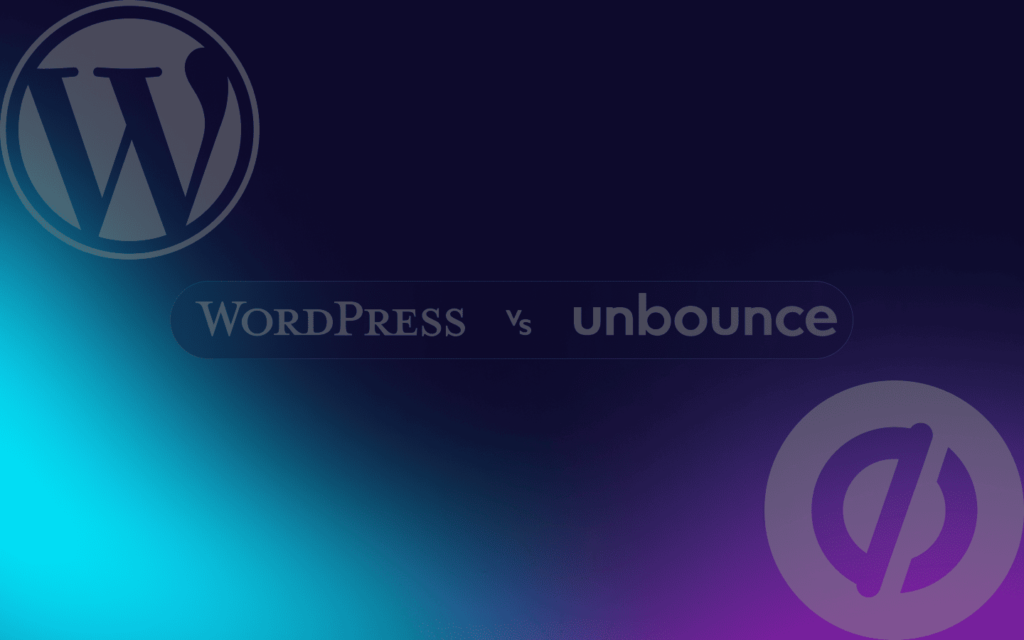
When you’re looking for the best platform to create a landing page, you’re faced with a key choice: WordPress or Unbounce? Both platforms have their strengths and cater to different needs. The best option for you will depend on several factors, including your budget, the level of ease you prefer, and the specific features you need. In this article, we will dive into a detailed comparison between WordPress and Unbounce to help you make the right decision for your business.
What is a Landing Page?
A landing page is a web page specifically designed to convert visitors into leads or customers. It is often used as the destination for paid marketing or email campaigns, with a single purpose: to capture information or generate an action, such as a purchase, sign-up, or download
The success of a landing page depends on key factors such as conversion optimization, clear and effective design, functionality, and the integrations that allow you to monitor and improve its performance
Why is Choosing the Right Platform for Your Landing Pages Important?
The platform you choose for your landing pages will directly impact their conversion rate, the ease with which you can optimize them, and ultimately the return on investment (ROI) of your marketing campaigns. Choosing the wrong platform could mean a longer and more costly process, whereas the right one will allow you to scale and improve quickly
General Comparison Between WordPress and Unbounce
1. Flexibility and Customization

WordPress is known for being one of the most versatile platforms on the market. It is a fully customizable content management system (CMS) with a massive amount of themes, plugins, and visual builders (like Elementor or Divi) that allow you to create virtually any type of page, including landing pages.
- Advantages of WordPress:
- Absolute Flexibility: You can design landing pages with complete freedom and adjust all aspects, from the code to the visual design.
- Unlimited Integrations: WordPress can be integrated with practically any marketing tool, from email platforms to CRM, and it has a large developer community constantly creating new features.
- Scalability: Ideal for businesses that are growing and need a platform that can scale without issues.
Unbounce, on the other hand, is a tool specifically designed for creating landing pages with the purpose of optimizing conversions. It is focused on making the process of creating and testing landing pages easy for digital marketing, with an emphasis on quick results.
- Advantages of Unbounce:
- Drag-and-Drop Builder: You don’t need any programming knowledge. Everything is done visually, which is perfect for those without technical skills.
- Conversion Optimization: Unbounce includes pre-built features like forms, pop-ups, and sticky bars that make lead capture easier.
- Simplified A/B Testing: A/B testing is built-in, making optimizing your pages an easy and efficient process.
2. Ease of Use
When it comes to ease of use, Unbounce is definitely simpler. It was designed so that marketing teams without technical knowledge can quickly create and launch landing pages. Its drag-and-drop editor and ready-made templates simplify the design process.
On the other hand, WordPress can have a steeper learning curve, especially if you want to do a lot of advanced customizations. However, visual builders like Elementor or Divi help reduce this difficulty, making page design more accessible even for beginners.
3. Costs and Pricing Model
WordPress is a free, open-source platform, but there are associated costs, such as hosting, premium themes, and additional plugins. Depending on the tools you use, the cost can increase, especially if you’re looking for advanced features like A/B testing or specific integrations.
Unbounce operates on a subscription model, with monthly plans that include features like A/B testing and optimization tools. While it may be more expensive compared to WordPress (especially for a small site), the cost includes all the tools needed to quickly create, publish, and optimize landing pages.
4. Integrations and Plugins
WordPress integrates with practically any marketing platform, from email automation tools like Mailchimp to CRM platforms like HubSpot. With thousands of plugins available, you can add virtually any functionality you need.
Unbounce also offers integrations with popular marketing tools and CRMs, though it is more limited compared to WordPress. However, its integrations are generally easy to configure and are designed specifically to optimize marketing campaigns.
5. A/B Testing and Conversion Optimization

Regarding conversion optimization, Unbounce has the advantage of having A/B testing and analytics features built directly into the platform. This makes it easy to experiment with different versions of a page to see which generates better results.
WordPress allows A/B testing through plugins like Nelio A/B Testing or Thrive Optimize, but generally requires a more advanced setup and multiple plugins to achieve the same level of functionality that Unbounce offers by default.
Which Platform is Best for You?
Choose WordPress if…
- You need unlimited flexibility and customization.
- You have technical knowledge or a team that can handle the technical side, or if you prefer to learn how to do it yourself.
- You want a site that includes not only landing pages but also other sections like a blog, online store, etc.
- You have a tight budget and prefer to spend only on essentials.
Choose Unbounce if…
- You want to create fast and optimized landing pages without worrying about technical setups.
- You’re looking for an all-in-one solution that makes A/B testing and marketing integrations easy.
- You need quick results and prioritize simplicity and speed over complete customization.
- You are primarily focused on marketing campaigns and need to optimize conversions from day one.









